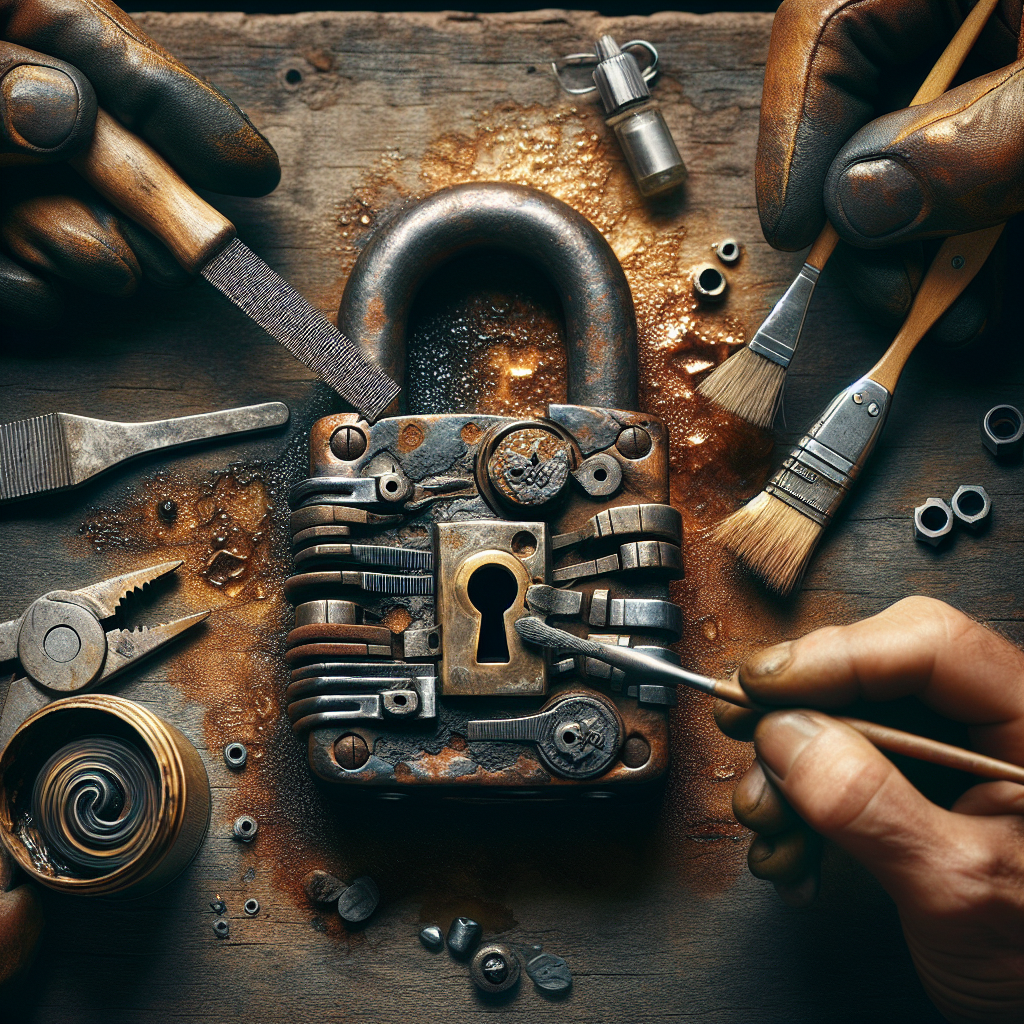In an age where most objects are mass-produced, antique locks stand out as relics of craftsmanship and mechanical ingenuity. These intricate devices, often ornate and made with precision, hold not just the literal key to their matching locks, but also to understanding the technological and artistic heritage of their times. The restoration of antique locks in Hempstead does more than preserve a functional item; it is a meticulous process aimed at conserving a piece of history. Artisans and experts in Hempstead approach such restorations with a blend of reverence for tradition and application of modern techniques, ensuring that these ancient mechanisms continue to operate and enchant for years to come.
Hempstead’s method of restoring these intricate masterpieces involves an intimate knowledge of metals and mechanisms that many modern-day locksmiths might never encounter. This region has developed a notable reputation for blending a respect for historical accuracy with the practical needs of contemporary use, ensuring that even the most faded and worn locks are given a new lease on life. In the sections to follow, we’ll delve deep into the key practices that set Hempstead’s restoration work apart, examine the tools and techniques that breathe new life into old metals, and discover how the hands of skilled artisans can turn a time-worn lock into both a functional device and a conversation piece imbued with the charm of a bygone era.
Key Takeaways
1. Hempstead’s approach to antique lock restoration emphasizes the preservation of historical integrity. Their restorers focus on maintaining the original appearance and functionality of the locks while ensuring that any repairs are in line with the era’s techniques and materials. This approach honors the craftsmanship and heritage of the piece, avoiding the use of modern replacements that would diminish the lock’s authenticity.
2. The restoration process begins with a thorough assessment of the lock’s condition. Experts meticulously disassemble the locks to understand their mechanism and structure. Such assessments help in determining the extent of damage and corrosion, which are critical for planning the restoration process, ensuring that every aspect of repair is considered before any work begins.
3. Specialist tools and techniques are employed to refurbish delicate components. Hempstead’s approach includes the use of tools that are often handmade to mimic the original crafting process of the lock. These may include custom files, chisels, and other devices. This ensures that the work done on the locks is as close as possible to how they would have been treated when they were first made.
4. Where replacement parts are necessary, restorers at Hempstead carefully recreate them to match the original pieces. They use period-appropriate materials and forge techniques that would have been available at the time the lock was made. This dedication to historical accuracy ensures that the restored lock remains true to its original design and function.
5. The restoration process is not just about physical repair but also involves research into the lock’s historical context. The restorers take the time to understand the provenance and historical significance of each lock, which can influence how restoration is carried out. This might involve studying similar pieces, consulting historical documents, or collaborating with historians to ensure the restored lock is a reflection of its time.
What Techniques Does Hempstead Utilize in Restoring Antique Locks?
Evaluation of Antique Lock Condition
Initially, Hempstead’s antique lock restoration process involves a thorough assessment of the lock’s current state. Specialists meticulously inspect each component for signs of wear, corrosion, and other damages. Factors such as historical significance, material composition, and mechanical complexity are also taken into consideration to determine the most appropriate restoration methods.
Cleaning and De-rusting Process
Before any repairs can occur, all locks must undergo a gentle cleaning process. Hempstead employs non-invasive cleaning techniques to preserve the integrity of the antique. Chemical treatments are carefully selected to remove rust and build-up without compromising the lock’s material. Ultrasonic cleaning may be used for intricate parts where manual cleaning is impractical.
Preservation of Original Components
Maintaining the authenticity of the antique lock is paramount. Wherever possible, the original components are preserved. Skilled restorers painstakingly repair these pieces, utilizing traditional tools and techniques that reflect the period in which the lock was made. Any replacement parts required are crafted to match the original specifications in both form and function.
Reassembly and Lubrication
After cleaning and repairing or fabricating the necessary components, Hempstead’s experts reassemble the lock with precision. This assembly is followed by the application of period-appropriate lubricants, ensuring the lock operates smoothly without causing undue stress to the aged mechanics.
Key Duplication and Lock Mechanism Adjustment
In instances where keys are lost or damaged, Hempstead offers duplication services to recreate the original key based on the lock mechanism. Advanced techniques, such as impressioning and reverse engineering, are employed to craft a key that not only fits but complements the aesthetic of the lock. Adjustments to the spring tensioners and other mechanical components are fine-tuned for operational ease.
Finishing Treatments for Aesthetic Restoration
Attention to the aesthetic detail is crucial in antique lock restoration. Finishing treatments include polishing, patination, or coating the metal in ways that align with the era’s style. This not only helps in returning the lock to its former glory but also helps in protecting it from future degradation.
Installation and In-Use Care Recommendations
The final step in Hempstead’s restoration process includes the proper installation of the lock into its original setting. Experts provide specific care instructions tailored to the type of lock and its intended use, ensuring longevity and continued functionality for years to come.
What Are the Top Tips for Maintaining Restored Antique Locks?
- Regularly inspect the lock for any sign of wear or damage to preemptively address issues.
- Clean the lock gently and sparingly to prevent build-up without causing harm to its components.
- Use a proper lubricant designed for antique locks to ensure smooth operation without degrading the material.
- Limit exposure to extreme environments that can accelerate corrosion—avoid high humidity and temperature fluctuations.
- Consult with a professional for any maintenance or repair work to avoid accidental damage to the lock’s intricate parts.
What unique methods does Hempstead use for antique lock restoration?
Hempstead employs a combination of traditional locksmithing techniques and modern technology to ensure that the integrity and functionality of antique locks are preserved. Their approach often involves meticulous handcrafting, specialized metalworking, and where appropriate, the use of ultrasonic cleaners to remove years of grime without damaging the delicate mechanisms.
How does Hempstead ensure the originality of the restored locks?
To maintain the originality of each piece, Hempstead focuses on preservation over replacement. They work to conserve the original components wherever possible and source authentic materials when parts need to be replaced. This commitment helps ensure that the locks retain their historical value and charm.
Are the restored locks by Hempstead suitable for everyday use?
Yes, one of Hempstead’s goals is to return antique locks to full functionality, allowing them to be used daily. They carefully balance the aesthetic and historic aspects of the locks with the practical need for security and durability.
Can Hempstead service locks that are severely damaged or corroded?
Hempstead is capable of servicing severely damaged or corroded locks, often resorting to more intensive restoration processes. Their experts carefully assess each lock to determine the best course of action, which may involve intricate repairs or the reconstruction of severely deteriorated parts.
How long does a typical antique lock restoration project take?
The time required for restoring an antique lock can vary greatly depending on the lock’s condition and the complexity of the necessary repairs. Hempstead’s experts take the time necessary to ensure that each restoration meets their high standards, providing a transparent timeline after assessing the lock.
Does Hempstead offer customized solutions for unique or rare locks?
Hempstead prides itself on its ability to offer customized solutions for even the most unique or rare locks. They understand that each antique lock can present its own set of challenges and are equipped to devise bespoke strategies to restore them to their former glory.
Is Hempstead’s antique lock restoration process environmentally friendly?
Hempstead is committed to sustainability and strives to use environmentally friendly methods and materials throughout their restoration processes. This commitment extends from the cleaning agents used to the disposal of any waste.
How does Hempstead handle the security concerns of antique lock owners?
For clients concerned about the security of their antique locks, Hempstead offers solutions that enhance security while respecting the historical significance of the lock. They can incorporate modern locking mechanisms discreetly or provide advice on how to use antique locks in conjunction with contemporary security systems.
Does Hempstead provide documentation or certificates for their restorations?
Upon completion of a restoration project, Hempstead can provide detailed documentation or a certificate of restoration that outlines the work carried out, materials used, and any historical significance noted. This can be particularly valuable for insurance or resale purposes.
Can Hempstead source replacement keys for antique locks?
Yes, if a key is missing or too damaged to be used, Hempstead has the expertise to create replacement keys that are true to the original design and function effectively with the restored lock.
Final Thoughts on Hempstead’s Antique Lock Restoration
The art and skill involved in restoring antique locks cannot be overstated, and Hempstead’s approach exemplifies the dedication needed to bring historic pieces back to life. Their careful blending of traditional locksmithing with modern techniques allows them to effectively restore functionality while honoring the past. The tailored, client-focused services they offer ensure that each lock’s story continues while providing modern-day security and practicality. As Hempstead’s antique lock restoration services continue to evolve, they maintain a crucial link between the craftsmanship of yesteryear and the needs of today.
For anyone owning antique locks, be it for their sentimental value, historical significance, or aesthetic appeal, trusting a restoration expert like Hempstead can be a rewarding experience. Not only do they safeguard the tangible pieces of history, but they also preserve the intangible stories and craftsmanship that those locks represent. Ultimately, Hempstead’s commitment to detail, sustainability, and client’s needs solidifies their reputation as a trusted authority in the niche yet vital field of antique lock restoration.







